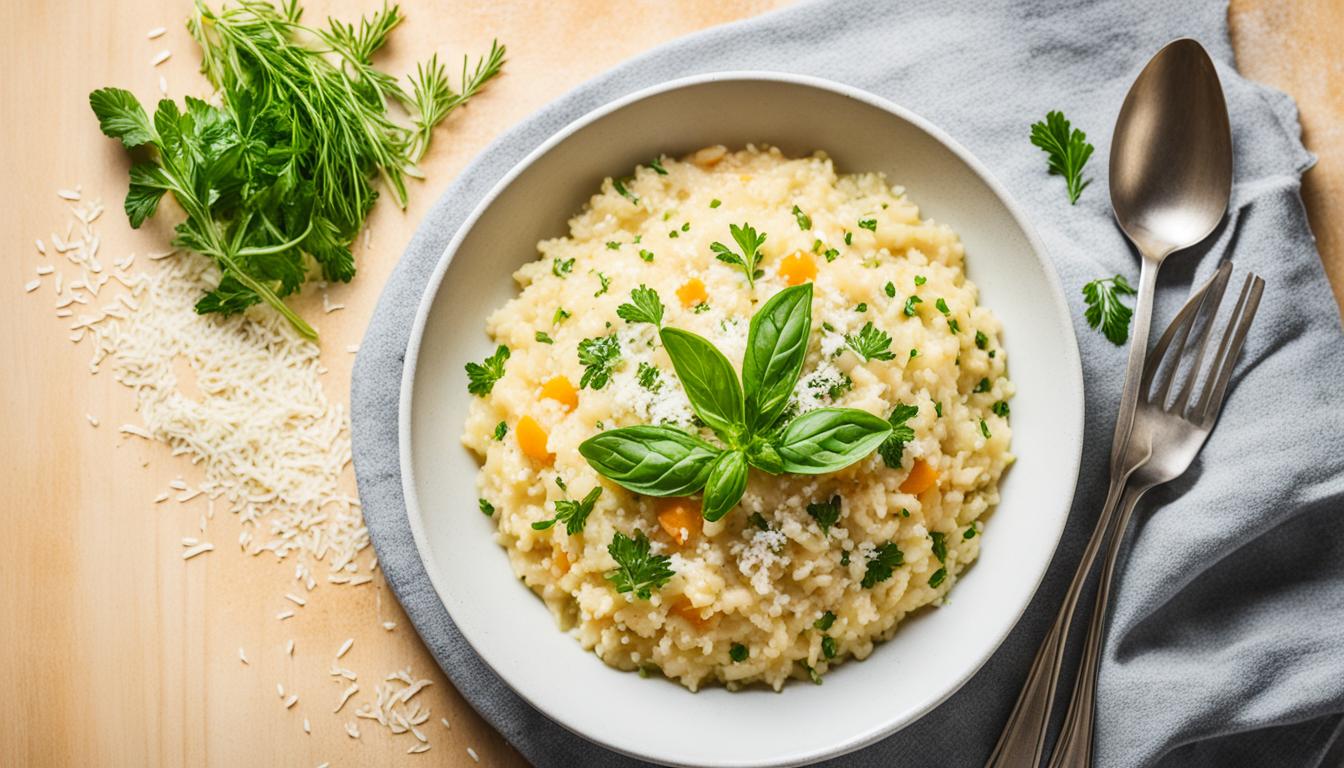Risotto is a well-loved Italian rice dish that’s become popular around the world. It’s creamy, full of flavor, and made with special starchy rice like Arborio, Carnaroli, or Vialone Nano. Since rice is naturally free of gluten, risotto is usually safe for those avoiding gluten. But, there are a few things to watch out for with risotto’s gluten-free status.
What could make risotto not gluten-free? It’s the broth and other ingredients added to it. Ordering risotto at a restaurant or choosing prepackaged risotto mixes requires extra care to avoid gluten. Knowing about risotto’s gluten content helps those on a gluten-free diet enjoy this delicious Italian dish safely.
Key Takeaways:
- Traditional risotto is made with starchy, short-grain rice.
- Risotto is generally considered gluten-free, but it depends on the ingredients used.
- Be cautious of the broth and additional ingredients that may contain gluten when ordering risotto at a restaurant or buying prepackaged mixes.
- Individuals on a gluten-free diet can still enjoy risotto by choosing gluten-free options and cooking carefully at home.
- Follow gluten-free cooking tips to avoid cross-contamination and enjoy a delightful, gluten-free risotto experience.
What is Risotto and How is it Made?
Risotto is a tasty rice dish from Northern Italy. It’s made with short-grain rice like Arborio. The rice gets creamy as it cooks slowly in broth. You can add veggies, meat, cheese, and herbs for more flavor.
To make it, you start by toasting the rice in butter or oil. Then, you add warm broth bit by bit, stirring a lot. This slow cooking and stirring make the rice creamy by releasing its starches.
“Risotto is all about stirring and the slow addition of broth. The continual stirring helps release the starches from the rice, creating a creamy consistency.”
First, you sauté the rice in butter or oil with onions or shallots. Then you add chicken or vegetable broth little by little. You have to keep stirring. You do this until the rice is tender yet slightly firm.
Next, you mix in extra ingredients like vegetables or cooked meats. Then comes grated cheese and fresh herbs. These add lots of flavors.
“The beauty of risotto lies in its versatility. You can create endless flavor combinations by adding ingredients like mushrooms, peas, pancetta, Parmesan, or even seafood.”
The last step, mantecatura, is where you stir in butter and cheese until it’s creamy. This makes the dish rich and velvety.
Making risotto takes time and patience. But, the creamy and flavorful result is worth it.
| Ingredients | Quantity |
|---|---|
| Arborio rice | 1 cup |
| Chicken or vegetable broth | 4-6 cups |
| Butter or olive oil | 2 tablespoons |
| Onion or shallots, finely chopped | 1/2 cup |
| Garlic, minced | 2 cloves |
| White wine | 1/2 cup |
| Additional ingredients (e.g., vegetables, cheese, meat, herbs) | To taste |
| Butter and grated cheese for mantecatura | To taste |
Understanding Gluten and Gluten-Free Diets
Gluten is found in wheat, barley, rye, and triticale. It helps give many baked goods their stretchiness and texture. Yet, for those with celiac disease, gluten sensitivity, and wheat allergy, eating gluten can harm their health.
Celiac disease is when gluten eats away at the small intestine. This can cause trouble digesting food and nutrient problems over time.
People with gluten sensitivity or a wheat allergy might feel bloated, have stomach pain, diarrhea, or get skin rashes from gluten. How bad these symptoms are can change from person to person.
A gluten-free diet means not eating gluten at all. This diet is key for controlling celiac disease, gluten sensitivity, and wheat allergy. Not having gluten can help ease symptoms, help the gut heal, and keep health good.
Risks of Non-Compliance with a Gluten-Free Diet
For those with celiac disease, a bit of gluten can harm the small intestine more. This can cause big problems like not getting enough nutrients, weaker bones, and a higher chance of some autoimmune diseases.
Not avoiding gluten can also trouble people with gluten sensitivity and wheat allergy. They must strictly not eat gluten to stop bad reactions.
It’s key to follow a gluten-free diet with a doctor’s advice, especially for celiac disease. Doctors can offer custom tips, support, and check-ups to make sure the diet works well and is healthy.
“Adhering to a gluten-free diet is crucial for individuals with celiac disease, gluten sensitivity, or wheat allergy. It offers relief from symptoms, promotes gut healing, and minimizes the risk of complications.”
| Condition | Key Characteristics |
|---|---|
| Celiac Disease | Autoimmune disorder that damages the small intestine in response to gluten ingestion. |
| Gluten Sensitivity | Non-celiac condition where individuals experience symptoms after consuming gluten. |
| Wheat Allergy | An allergic reaction to wheat proteins, including gluten. |
Going gluten-free can be hard, but there are many gluten-free foods out there. You can eat grains like rice, corn, quinoa, and flours from potatoes, tapioca, and nuts. These help keep a gluten-free diet both healthy and pleasing.
Risotto and the Gluten-Free Diet
Risotto is mainly made with rice, which doesn’t have gluten. But, we need to watch out for gluten in other ingredients. The broth for cooking the risotto might have gluten from added flavors. Also, things like processed meats or spice mixes could have gluten too.
To have a safe gluten-free risotto, always read labels and pick gluten-free options. When eating out, tell the staff about your gluten-free needs. Ask them how they make their food. This can help you steer clear of gluten. Always look for gluten-free labels and certifications.
To summarize:
Risotto can be affected by gluten contamination through:
- Broth: Check the broth’s ingredients for gluten-containing additives or flavors.
- Additional Ingredients: Watch out for processed meats or spices. They might have gluten that could affect the risotto.
Selecting the right ingredients and cooking with care means you can enjoy gluten-free risotto.
Preventing Cross-Contact
Avoid gluten touching your gluten-free risotto at home. Here are some ways to do it:
- Separate Utensils: Use different utensils and pots for gluten-free cooking. This helps avoid gluten from getting into your dish.
- Clean Surfaces: Clean all kitchen surfaces and tools well before cooking gluten-free meals.
- Labeling: Mark your gluten-free ingredients to avoid mixing them up with others.
Choosing Gluten-Free Ingredients
Pick the right ingredients for gluten-free risotto like this:
- Rice: Use Arborio, Carnaroli, or Vialone Nano rice, all naturally free of gluten.
- Broth: Choose broths that are marked gluten-free, or make your own with safe ingredients.
- Seasonings and Flavors: Flavor your risotto with gluten-free herbs, spices, cheeses, and more.
By paying attention to ingredients and how you cook, you can enjoy tasty and safe gluten-free risotto.
Health Considerations for Gluten-Free Diets
If you are on a gluten-free diet, thinking about the nutrition of your food is key. Risotto, a beloved Italian rice dish, is a great option. Let’s look at how risotto can fit into your gluten-free diet with health in mind.
The Nutritional Profile of Risotto
Risotto starts with rice, which doesn’t have gluten. The nutrition of risotto changes depending on what you put in it. We’ll go over the main nutrients in a standard risotto serving:
| Nutrient | Amount per Serving |
|---|---|
| Calories | Approximately 250-300 calories |
| Carbohydrates | Approximately 40-50 grams |
| Fats | Varies depending on added ingredients |
| Proteins | Varies depending on added ingredients |
Risotto has a lot of carbs because it’s made with rice. Adding butter, cheese, and meat changes the fat and protein amounts. But these will depend on what the recipe calls for and how much you eat.
Incorporating Risotto into a Balanced Diet
Risotto can make your gluten-free diet more enjoyable. But, it’s important to watch how much you eat and what you eat it with. Here’s how to make it a balanced part of your meals:
- Combine it with proteins like lean meats or seafood for a more filling meal.
- Mix in different veggies to up the fiber and nutrients.
- Control your portions to match your dietary needs and goals.
But remember, everyone’s nutritional needs differ. So, you should talk to a health expert or dietitian for advice that fits you.
Making Gluten-Free Risotto at Home
Making gluten-free risotto at home is simple and fun. Use the right ingredients and some techniques. You’ll make a tasty risotto that’s safe for a gluten-free diet.
First, pick a gluten-free rice like Arborio, Carnaroli, or Vialone Nano. These rices have the right starch for a creamy texture.
Make sure to use a gluten-free broth. Read store-bought broth labels or make your own. This ensures no hidden gluten.
For extra flavor, use gluten-free seasonings. Fresh herbs, spices, and veggies add great taste without gluten.
“Gluten-free risotto is versatile. It can include veggies, meats, or seafood. Feel free to experiment and adapt recipes to your liking.”
There are many gluten-free risotto recipes out there. You can find ones with mushrooms, lemon and asparagus, or chicken and spinach. There’s something for everyone.
Use these recipes as guides, but make them your own. Adding your favorite things or using what’s in season can make your risotto even better.
Keep your kitchen gluten-free to avoid cross-contamination. Use separate tools and spaces for gluten-containing things. This keeps your risotto safe.
Try different gluten-free risotto recipes for a creamy treat. With these tips, you’ll enjoy risotto and stay gluten-free.
Gluten-Free Risotto Recipe Ideas
Here are some gluten-free risotto recipes to try:
- Butternut Squash Risotto with Sage and Parmesan
- Spinach and Feta Risotto with Lemon Zest
- Shrimp and Roasted Red Pepper Risotto
These recipes are just starting points. Add your own twist to make them special. Be creative!
Risotto: A Gluten-Free Italian Classic
Risotto is a beloved dish from Italy that has won hearts around the globe. Unlike pasta, which has gluten, risotto uses gluten-free rice. This makes it a top choice for those avoiding gluten.
People who don’t eat gluten can enjoy this creamy, flavorful dish without worry. By picking gluten-free ingredients and avoiding cross-contamination, risotto stays safe. This means everyone can enjoy it, even those with special diets.
At Italian restaurants, telling the staff about your gluten-free needs is key. This way, you can be sure the risotto will be safe to eat. It makes dining out stress-free.
Italian cooking is famous for its deep flavors and variety. Risotto shows off these traits well. It mixes rice, broth, and herbs beautifully. Plus, it’s gluten-free, which means more people can try this Italian classic.
Risotto can be enjoyed out or made at home. It’s a tasty and flexible dish that suits a gluten-free diet well. Don’t be afraid to mix in different ingredients. This way, you can discover many tasty combinations.
Gluten-Free Risotto Recipes to Try
If you’re searching for tasty gluten-free risotto dishes, you’ve hit the jackpot! Lots of delicious options await you. Whether you love classic cheese risotto, a Greek-style spin, or a dish filled with veggies, there’s something for every taste.
1. Cheese Risotto
A classic cheese risotto is perfect for those comfort food moments. It swaps pasta for rice, making it gluten-free. You can add Parmesan, goat cheese, or your favorites. It’s bound to please everyone.
2. Greek-Style Risotto
Get a taste of the Mediterranean with a Greek-style risotto. It’s full of shrimp, asparagus, feta cheese, and a lemon juice burst. It’s a fantastic way to shake up the risotto routine.
3. Vegetable Risotto
Veggie lovers will fall for this vegetable risotto. Mix in broccoli, squash, onion, and kale for a hearty meal. It’s not only tasty but also a feast for the eyes with its colorful veggies.
Ready to cook for yourself, your family, or a dinner party? These gluten-free risotto recipes are a great starting point. Feel free to tweak them with different ingredients or toppings to match your taste. Dive into the kitchen adventure and savor these gluten-free risottos.
Now, let’s start cooking some amazing gluten-free risotto dishes! They promise to satisfy your cravings and dazzle your senses. Get ready for an awesome dining experience with these gluten-free delights.
Tips for a Successful Gluten-Free Risotto Experience
Making gluten-free risotto can be both easy and safe with the right tips. These strategies help you cook a delicious risotto that fits your diet. You won’t have to sacrifice taste or safety.
1. Read labels and choose certified gluten-free ingredients
It’s vital to read ingredient labels closely. Choose products that are certified gluten-free. This ensures they’re safe to eat. Avoiding hidden gluten keeps your risotto pure.
2. Prevent cross-contamination
Cross-contamination happens when gluten-free food touches gluten. Use different utensils and pots for gluten-free cooking. This keeps your risotto safe.
3. Communicate your dietary needs
Eating out? Tell the restaurant staff you eat gluten-free. Ask about how they make their risotto. This helps them serve you a safe, gluten-free meal.
4. Explore gluten-free cooking tips
Learn more gluten-free cooking tricks. These can improve your risotto. Look for advice on substitutes and spices. This makes your risotto better and more interesting.
5. Stay informed and keep experimenting
The gluten-free world is always changing. Keep up with new trends and techniques. Try different ingredients and recipes. This will make your gluten-free risotto exciting and tasty.
Start with the right ingredients and kitchen tools. Communicate your food needs clearly. These steps help you enjoy safe and yummy gluten-free risotto.
Conclusion
Risotto can be a great gluten-free dish with the right stuff and a gluten-free kitchen. Rice, the main part of risotto, is gluten-free. But be careful with the broth and extra stuff you add.
To enjoy gluten-free risotto, pick gluten-free items and read labels well. Also, tell others about your diet needs. This way, you can enjoy risotto’s creamy taste safely. There’s a lot of gluten-free risotto recipes to try.
If you’re avoiding gluten for health reasons or by choice, don’t miss out on risotto. You can make it fit your diet and still taste amazing. Just pick your ingredients carefully and enjoy your gluten-free meal.





